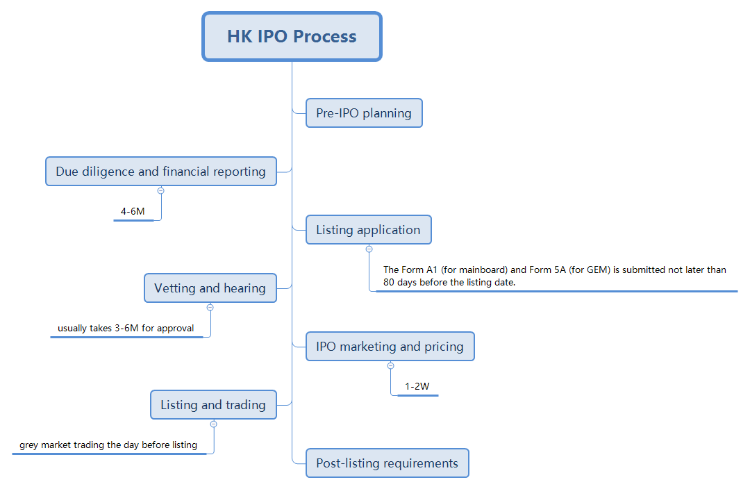From Dream to Reality: Unveiling the Electrifying HK IPO Adventure and the Road to Listing Excellence
The Hong Kong Stock Exchange (HKEX) is one of the largest stock exchanges in the world and a popular destination for companies looking to go public through an initial public offering (IPO).
Many of you may wonder how a company processes its IPO through the stock exchange and what criteria that a stock exchange requires for a listing company. In this section, we’ll lead you to understand the cooperation between a listing company and the stock exchange.
To conduct an IPO on the HKEX, a company needs to follow the regulatory requirements under the Securities and Futures Ordinance and the Listing Rules of the HKEX.
Here are some of the key steps in the IPO process on the HKEX:

1. Pre-IPO planning: A company planning to go public will need to choose a sponsor, typically an investment bank, to guide them through the IPO process and ensure they meet the regulatory requirements of the HKEX.
2. Due diligence and financial reporting: A company must produce audited financial statements that meet the International Financial Reporting Standards (IFRS) and comply with HKEX's financial reporting disclosure requirements.
During the first two stages, you can stay updated on IPO news: keep a close eye on financial news outlets, IPO-specific platforms, and reputable investment websites. These sources often provide updates, announcements, and analysis regarding upcoming IPOs and the companies involved.
3. Listing application: The company will then submit a listing application to the HKEX, which includes information on its operations, financials, and share structure.
During this stage, you can conduct thorough research on the company filing for an IPO. Examine its business model, competitive landscape, financial health, growth prospects, and any potential risks or challenges it may face. Utilize resources such as company prospectuses, SEC filings, analyst reports, and industry publications to gather comprehensive information.
You can also evaluate underwriters and analysts’ recommendations: pay attention to the underwriters and their analysts’ opinions on the IPO. Investment banks and underwriters often publish research reports, including recommendations and target prices, based on their analysis of the company. Assess their track record and reputation in the market to gain additional perspectives on the IPO.
4. Vetting and approval: The HKEX and the Securities and Futures Commission will vet the company's listing application and prospectus to ensure they meet the HKEX's listing requirements.
During this stage, you should monitor the IPO progress: stay updated on the progress of the IPO, including the pricing and allocations. Be aware of key dates, such as the opening of trading for the stock on the exchange. Monitor market sentiment, investor demand, and any significant developments that may impact the IPO’s performance.
5. IPO marketing and pricing: Once the listing is approved, the company will work with the sponsor to set the IPO launch date and conduct investor roadshows to market the offering. During the roadshows, they will also set the IPO price.
During this stage, you can assess the IPO valuation and decide whether to participate in the IPO. Evaluating the company’s valuation involves analyzing pricing details, comparing the valuation to industry peers, and considering fundamental factors like revenue growth, profitability, and market outlook. This analysis will help in determining whether the IPO is attractively priced relative to its potential. Once you have conducted sufficient research and analysis, you can decide whether to participate in the IPO.
6. Listing and trading: On the day of the IPO launch, the shares are listed and will begin trading on the HKEX. The valid period for a listing application from the submission to the listing date is six months.
When trading IPOs, you should exercise caution and diversification. While IPOs can offer attractive opportunities, they also have risks. Investors must carefully assess their risk appetite and consider diversifying their investment portfolio to mitigate potential pitfalls associated with investing in a single IPO.
7. Post-listing requirements: After listing, the company must continue to meet ongoing regulatory requirements, including disclosing material information to investors, filing financial statements, and complying with corporate governance requirements.
It's important to note that the exact process and requirements can vary depending on the specific circumstances of each company. Preparation for the listing process in Hong Kong requires 2 to 3 years of careful and strict planning before implementation.

Listing Criteria
Before a company can be listed on the Hong Kong Stock Exchange, it has to meet certain criteria. The HKEX has two listing boards – the Main Board and GEM (Growth Enterprise Market).
The listing criteria for the Main Board include:
1. Trading record of at least three financial years
2. Management remains unchanged for the last two financial years
3. Ownership remains unchanged for the latest financial year
One of the following tests must also be fulfilled:
1. Profit test:
● Latest three years aggregate profit needs to be equal or greater than HKD 50 million of which the first two years had an aggregate profit of at least HKD 30 million and the third year a profit of at least HKD 20 million.
● Market capitalization at the time of listing of at least HKD 500 million.
2. Market capitalization/Revenue test:
● Latest year revenue of at least HKD 500 million and market capitalization of at least HKD 4 billion.
3. Market capitalization/Revenue/Cash flow test:
● Market capitalization of at least HKD 2 billion, revenue of at least HKD 500 million for the latest financial year and operating cash flow of at least HKD 100 million in the aggregate for the three preceding financial years.
● Management remains unchanged for the last three years.
● The company has at least 300 shareholders.
● Ownership remains unchanged during the latest year.
● Public float of at least 25%.
A typical Main Board IPO has two tranches of offering: (1) one offer tranche available to retail investors; and (2) one international offer or “placing” tranche available to institutional investors.

The main listing criteria for GEM is more relaxed, and it requires:
● Latest two years aggregate operating cash flow of at least HKD 30 million.
● Market capitalization of at least HKD 150 million.
● Management has remained unchanged for the last two financial years.
● Ownership remains unchanged for the latest financial year.
● Public float of at least 25%.
Useful website for more information: